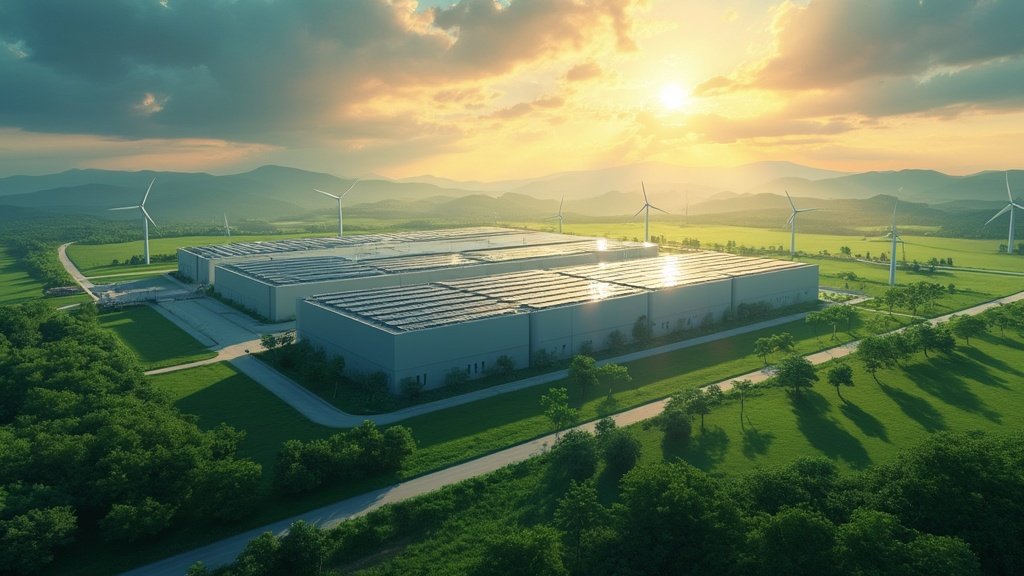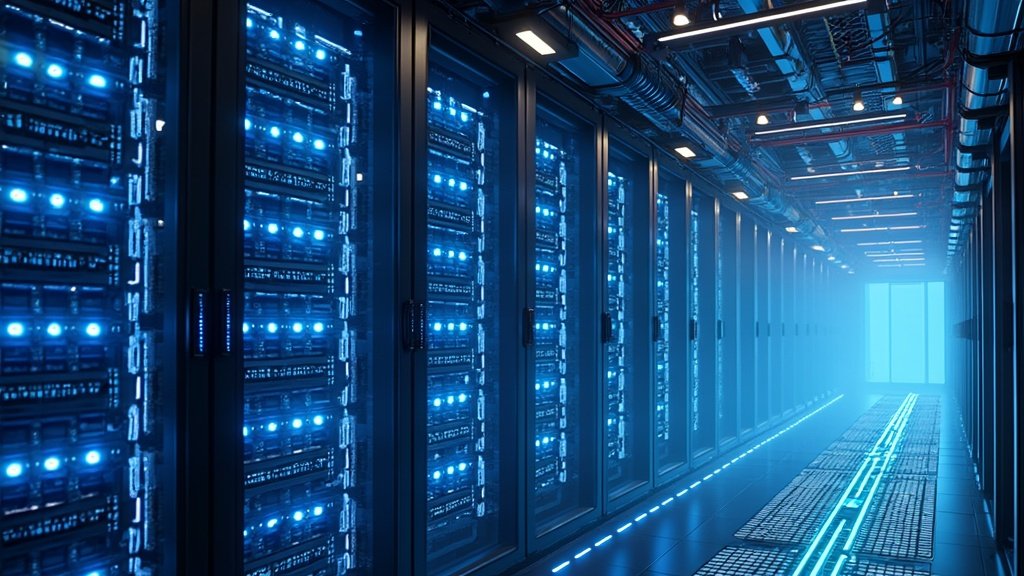In recent years, hyperscale data centers have solidified their position as the backbone of the digital economy, functioning as essential infrastructure for powering a diverse range of modern technologies. From cloud computing and artificial intelligence (AI) to machine learning and big data analytics, these colossal facilities are designed to manage immense volumes of data with unmatched efficiency, scalability, and speed. As a result, they have become indispensable in our technology-driven world.
Staying updated on the latest innovations in hyperscale data centers is crucial as businesses increasingly rely on advanced data processing and storage capabilities to maintain their competitive edge. From revolutionary cooling systems and the adoption of renewable energy solutions to advancements in server technology and AI-driven automation, these facilities are continuously evolving to address the skyrocketing demand for faster and more sustainable digital infrastructure.
This article delves into the dynamic world of hyperscale data centers, offering a comprehensive overview of their current state and future trajectory. We explore their rapid evolution, highlight the cutting-edge technologies shaping their development, and outline practical strategies for businesses to capitalize on these advancements. Whether you’re a technology professional, a strategic decision-maker, or simply an enthusiast eager to understand the driving forces behind modern digital infrastructure, this guide aims to provide the insights you need to stay competitive in a rapidly changing industry.
Key Takeaways
- Rapid Growth: The hyperscale data center market is expanding rapidly, with projections indicating that the number of such facilities will exceed 500 by 2025. This growth is driven by the increasing demand for cloud services, digital transformation, and data processing capabilities.
- Sustainability Matters: As environmental concerns take center stage, hyperscale data centers are prioritizing sustainability. Companies are adopting energy-efficient technologies, renewable energy sources, and innovative cooling solutions to reduce their carbon footprints.
- Edge Computing Integration: The rise of edge computing is reshaping the landscape of hyperscale data centers. By processing data closer to the source, organizations can achieve lower latency and improved user experiences, making this a crucial component of future data strategies.
- 5G Revolution: The implementation of 5G technology is set to transform hyperscale data centers by enabling faster data transmission and processing, accommodating the growing demands of connected devices and applications.
- Adapt and Innovate: To thrive in the evolving data environment, businesses must stay informed about these trends, adapt their strategies accordingly, and leverage new technologies to enhance their operations and service offerings.
The output is: INSERT_ELEMENTOR id=”37″
The Rise of Hyperscale Data Centers: A Quick Overview
Hyperscale data centers are revolutionizing digital infrastructure, managing thousands of servers and petabytes of data with unprecedented efficiency. These facilities power crucial technologies like cloud services, AI, and big data analytics, setting new standards for scalability and performance.
The market is surging—Synergy Research Group forecasts over 500 hyperscale facilities worldwide by 2025. This growth is driven by increasing cloud computing demands, remote work adoption, e-commerce expansion, and widespread digital transformation.
These mega-facilities offer more than just size. Their advanced infrastructure adapts quickly to market changes while maintaining exceptional reliability. As AI, machine learning, and IoT technologies evolve, hyperscale data centers are transforming to support an increasingly data-driven future.
Embracing Sustainability: The Green Data Center Movement
- Rising Importance of Sustainability: Hyperscale data centers are shifting focus to reduce carbon footprints and energy consumption.
- Environmental Awareness Growth: Increased global concerns about environmental impacts are driving companies to adopt greener practices.
- Industry Commitment: A report by the Uptime Institute reveals that 34% of data center operators prioritize sustainability in their strategies.
- Innovative Cooling Solutions: Adoption of advanced cooling technologies like liquid cooling systems significantly reduces energy and water usage.
- Renewable Energy Integration: Solar, wind, and hydropower are increasingly being used to power hyperscale data centers.
- Energy-Efficient Designs: Modern data centers incorporate smart sensors, AI-powered optimizations, and eco-friendly materials for improved efficiency.
- Modular Construction: Modular designs allow scalability and reduced resource waste in data center construction.
- Economic Benefits: Sustainable practices lead to long-term cost savings by lowering energy bills and improving operational efficiency.
- Global Sustainability Goals: The green data center movement supports worldwide initiatives to combat climate change and promote eco-friendly innovations.
- Leadership in Sustainability: Hyperscale data centers adopting sustainable strategies position themselves as leaders in the digital and environmental revolution.

The Role of Edge Computing in Hyperscale Data Centers
As the need for real-time data processing surges, edge computing has emerged as a cornerstone of hyperscale data center strategies. By positioning computational power and storage closer to end users, edge computing significantly reduces latency, enhancing the overall user experience. Industry insights from Gartner predict that by 2025, more than 75% of enterprise-generated data will be created and processed outside traditional centralized data centers.
Forward-thinking Businesses are increasingly integrating edge computing into their hyperscale infrastructures. This hybrid model combines the strengths of centralized and distributed computing, enabling organizations to adapt swiftly to evolving market demands while delivering seamless, high-quality services. Companies slow to adopt edge computing risk falling behind competitors already capitalizing on the advantages of this transformative approach to data management.

The Future of Networking: 5G and Beyond
Another trend reshaping hyperscale data centers is the rollout of 5G technology. With its ultra-low latency and high-speed capabilities, 5G is set to revolutionize how data is transmitted and processed. This advancement will significantly impact hyperscale data centers, enabling them to handle the exponential growth of data generated by connected devices and applications.
For instance, as more industries adopt IoT solutions, the volume of data needing processing will skyrocket. Hyperscale data centers equipped with 5G capabilities can efficiently manage this influx, allowing businesses to harness the full potential of their data. Moreover, the integration of advanced networking technologies, such as software-defined networking (SDN) and network function virtualization (NFV), will further enhance the agility and scalability of these facilities.
Conclusion: Staying Ahead in the Hyperscale Data Center Landscape
In summary, the latest trends in hyperscale data centers highlight the importance of sustainability, edge computing, and advanced networking technologies. As we move forward, businesses must prioritize these elements to remain competitive in an increasingly data-driven world. By embracing these trends, organizations can optimize their operations, enhance their service offerings, and ultimately drive growth.
The hyperscale data center landscape is evolving rapidly, and keeping abreast of these changes is essential for success. The future belongs to those who can adapt, innovate, and leverage the power of data to create unparalleled experiences for their customers.
FAQs
What are hyperscale data centers?
Hyperscale data centers are large-scale facilities that accommodate vast amounts of data processing and storage. They typically house thousands of servers and feature designs that maximize efficiency, scalability, and reliability, primarily supporting cloud service providers and large enterprises.
Why is sustainability important in hyperscale data centers?
Sustainability is crucial in hyperscale data centers because they consume significant amounts of energy and have a substantial environmental impact. By adopting energy-efficient technologies and renewable energy sources, companies can reduce their carbon footprints, lower operational costs, and enhance their corporate image among environmentally conscious consumers.
How does edge computing benefit hyperscale data centers?
Edge computing benefits hyperscale data centers by reducing latency and improving data processing speeds. By bringing computation closer to the data source, businesses can deliver real-time services and applications, thereby enhancing user experiences and optimizing their operations.
What role does 5G play in hyperscale data centers?
5G technology plays a pivotal role in hyperscale data centers by enabling faster data transmission and lower latency. This advancement allows data centers to handle the increasing volume of data generated by connected devices and applications, ultimately leading to improved performance and user experiences.
How can businesses stay competitive in the hyperscale data center landscape?
To remain competitive in the ever-evolving hyperscale data center landscape, businesses must focus on several key strategies. First and foremost, prioritizing sustainability is essential. By adopting energy-efficient technologies and incorporating renewable energy sources into their operations, companies can not only reduce their environmental footprint but also meet rising regulatory standards and appeal to eco-conscious stakeholders. Additionally, integrating edge computing solutions allows businesses to bring data processing closer to users, reducing latency and improving overall customer experiences.
Moreover, implementing advanced networking technologies like 5G is crucial for enabling faster and more reliable data transfer, which is increasingly important as data-intensive applications continue to grow. Beyond infrastructure advancements, businesses should stay vigilant about emerging trends in the industry, such as advancements in artificial intelligence, automation, and cybersecurity. Keeping pace with these developments ensures that companies are well-prepared to adapt to changes in the market.
Lastly, fostering a culture of continuous innovation is vital. Organizations must remain agile, experimenting with new technologies and refining operational processes to stay ahead of competitors. By combining these strategies—sustainability, edge computing, advanced networking, trend awareness, and innovation—businesses can not only maintain their foothold in the hyperscale data center landscape but also position themselves for long-term success.



